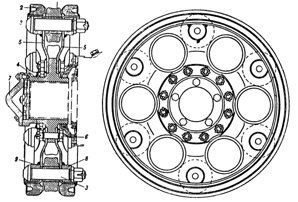
Plate 40 - Sprocket Wheel
| 2. Tyre 3. Roller shaft |
4. Hub of wheel 5. Disc |
6. Securing stud 7. Armoured cap |
8. Adapter 9. Bush |
Sprocket Wheel
The tank has two sprocket wheels at the rear, each
of identically the same design. The sprocket wheel is fitted to the splined end
of the driving shaft of the final drive. The wheel is fixed by a ring (Plate 40)
which is screwed by four studs to the end of the final drive shaft. The securing
ring is covered by an armoured cap. The hub (#4) of the wheel has a flange. In
later models the rims of the wheels are cast integrally with the discs and hubs.
The discs (#5) of the wheel are bolted to the flange. The discs have six large
exit holes for mud and snow and six seatings for the shafts of the rollers. To
prolong the life of the rims, steel tyres (#2) are fitted. The shafts (#3) are
housed between the discs and carry bronze bushes (#9) upon which the rollers
rotate.
As the sprocket wheel rotate they drive the tracks by means of the rollers which bear against the guide horns.

| 2. Tyre 3. Roller shaft |
4. Hub of wheel 5. Disc |
6. Securing stud 7. Armoured cap |
8. Adapter 9. Bush |
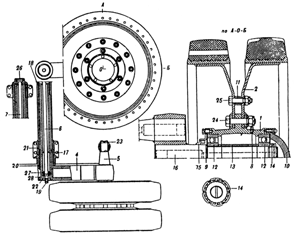
| 1. Hub 2. Disc 4. Suspension arm 5. Trunnion 6. Assembly looking spindle, 2nd, 3rd, and 5th bogies 7. Assembly looking spindle of 4th bogie 8. Lubricator |
9. External labyrinth seal 10. Armoured cap 11. Bush 12. Ball bearing 13. Distance piece 14. Nut |
15. Internal labyrinth seal 16. Bogie axle 17 & 18. Bushes 19. Lubrication aperture 20. Adjusting ring 21. Suspension arm shaft |
22 & 23. Washers 24. Fitted bolt 25. Bolt 26. Internal cap of suspension arm tube of 4th bogie 27. Ring 28. Nut |
Bogie Wheels and Cranks
All the bogie wheels are of the same
design. In the hub 1 (Plate 11-1) of the bogie wheel are pressed in two ball
bearings (#12). Between them there is a distance piece (#13). The bogie wheel is
attached to the fixed by a nut (#14) with lock. The hub of the bogie wheel is
covered by an armoured cap (#10). To the internal end of the hub is fastened a
labyrinth seal consisting of two rings (#9) and (#15). on the outside of the hub
there is a flange. The plates (#2) are fastened to the flange by bolts (#24).
Between them the plates are supported by bolts (#25) which rest in bushes (#11).
On the plates of the bogie wheel are pressed and welded steal rims with rubber
tyres.
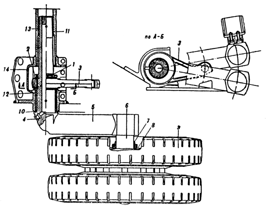
| 1. Nut 2. Lock Washer 3. Lever 4. Lubricator hole | 5. Suspension arm 6. Axle of wheel 7. Internal labyrinth seal | 8. External ring 9. Rubber tyre 10. Adjusting ring | 11. Front tube 12 & 13. Bronze bushes 14. Bracket |
The cranks serve to connect the bogie wheels to the hull of the tank and to the springs. Each crank consists of a suspension arm and two axles i.e. the suspension arm axle and the axle of the bogie wheel. The axle of the suspension arm rests in the hull in cast iron or bronze bushes. The bogie wheel is carried on its axle by two ball bearings. When movement of the bogie wheel takes place as it goes over an obstacle the crank rotates around its axle in the hull and compresses the spring. On each side of the tank there are five cranks i.e. one for each bogie wheel. The cranks of the bogie wheels, with the exception of the front ones are of exactly the same design. The axle of the bogie wheel (#16), the axle of the suspension arm (#21) and the trunnion (#5) for the attachment of the springs are pressed into the suspension arm and welded.
The opposite cranks of both sides of the tank are linked by bolts (#6) which safeguard them from lateral displacement. The cranks of the front bogie wheels are made in one piece with the axles which are carried in the front of the hull (Plate 42).

Idler Wheel and Track Adjuster The idler wheel is situated in the front part of the tank and serves to adjust the torsion of the tracks. The axle of the idler wheel is made in the form of a crank. The idler wheel is secured to the crank on two ball bearings and is fixed by nuts (Plates 45 and 46). The hub of the wheel is covered by an armoured cap. On the surface of the wheel two rubber tyred rims are shrunk on and welded (on tanks of the latest model there is no rubber on the idler wheel).
The axle of the crank rests in a bracket welded to the hull of the tank. By means of special nuts and locking bolts the axle is attached from inside the tank.
The end of the crank is toothed to mesh with the teeth of the ring welded to the bracket.
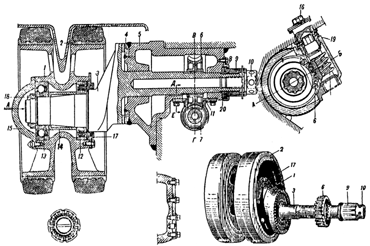
| 1. Body of wheel 2. Rubberized tyre 3. Crank 4. Toothed ring 5. Bracket |
6. Worm wheel 7. Worm 8. Flange 9. Nut 10. Stop bolt |
11. Casing of track adjuster 12. Roller bearing 13. Ball bearing 14. Spacer bush 15. Armoured cap |
16. Armoured plug 17. Cover with gland 18. Castellated nut 19. Adjusting packing 20. Ring |
Springs
Each bogie wheel has two separate springs. The springs of
the leading bogie are different from these of the remainder. The springs of the
leading bogies are of the coil type and one is situated inside the other (Plate
47). A rod travels inside the springs. This rod is attached to a lug which
connects it to the crank lever by means of a pin. On the lower half of the rod
is mounted the spring seating. The upper half of the rod travels in a guide bush
in the adjusting mechanism above the spring.
A guide nut and a check nut are threaded onto the end of the rod. The adjusting matrix is screwed into the adjusting nut. In later models there is no thread and a projection of the nut is welded into the adjusting assembly. The nut carries trunnion spigots, which are held in guide slots in the adjusting assembly. The spigot carriers are attached by pins to a bracket welded to the hull. When the spring is compressed the guide nut of the rod slides inside the adjusting assembly.
The action of the remaining springs is similar but they are different in design.
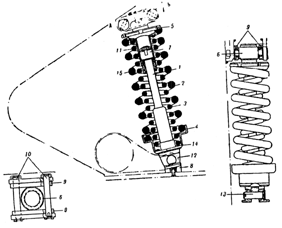
| 1. Rod 2. External spring 3. Internal spring 4. Seating of external spring |
5. Adjusting assembly 6. Adjusting nut 7. Nut 8. Buffer pad |
9. Spigot carriers 10. Pins 11. Check nut 12. Spring |
13. Pin 14. Guide ring 15. Guide bush |
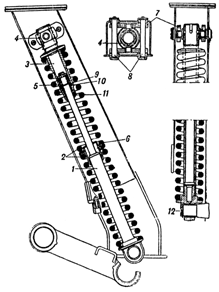
| 1. Rod 2. Springs 3. Adjusting assembly |
4. Adjusting nut 5. Nut of rod 6. Spring guide bush |
7. Spigot carriers 8. Pins of spigot carriers 9. Washer |
10. Rings 11. Guide bush 12. Cap |
Maintenance of the Suspension - Track Adjustment This is carried out in the following way :- The locking bolt of the axis of the crank is unscrewed to 12 to 15 mm. The nut is turned until the teeth of the crank and the bracket are no longer meshing. The unscrewing of the locks and nuts is carried out from the driving compartment. The nut is unscrewed by a special spanner.
In tanks with wireless sets it is necessary before adjusting the right hand track to turn the receiver lamp bracket through 90°. The key spanner unscrews the armoured plug in the nose plate of the hull. With the same key spanner turning the worm of the track adjusting mechanism, turn the crank in the necessary direction. When the tracks are normally adjusted there should be no flap and the middle part of the tracks should rest on top of the bogie wheels. After adjusting the tracks it is necessary to tighten the nut in the driving compartment, and replace the locking bolt. It is necessary to pay attention to see that the teeth of the crank are in mesh with the teeth of the bracket. If this is not so the axle of the crank is apt to break.
Fitting Tracks to the Tank
The tracks should be laid out in front
of the tank. If both tracks have to be put on then it is necessary to draw the
tank over the tracks by means of another tank or a tractor. On the other hand,
if only one track has to be put on the tank can move under its own power. The
tank should be moved over the tracks so that the last bogie wheel is resting on
the one but last track link. It is also possible to position the tank over the
tracks by lifting up one side of the hull with a jack. The crank of the track
adjusting mechanism should be turned to the extreme rear position.
Join the front track link to the sprocket wheel by means of a steel cable. The cable should bc connected to two hinges of the track pin, at one end while the other end should be connected to a hinge pin resting between the two discs of the sprocket wheel.
The cable should then be wound round the sprocket wheel as though it were a capstan by engaging reverse gear a little bit at a time. The track should be pulled by the cable until the front track link reaches the sprocket wheel. Then disconnect the sprocket wheel by engaging 1st gear. Bring the upper run of the track into mesh with the sprocket with a crowbar. Pull the track with the sprocket by engaging reverse gear. Connect the track links with a track pin closing them up with the special device (Plate 49). Finally tension the track.
It is possible to fit one track without using a cable. Drive the tank so that the rear bogie rests on the track link 12th or 13th from the rear. Lever the track from the rear bogie by means of a baulk of timber and bring it into mesh with the sprocket by means of a crowbar. Drive the tank in 1st gear at a low engine speed over the track supporting the upper run of the track with a crowbar. Move the tank until the leading bogie rests on the second from front track link. Join the track links under the idler wheel by using the special device (Plate 49). Finally tension the track.
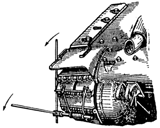
| Back to the Main Page | Disclaimer |